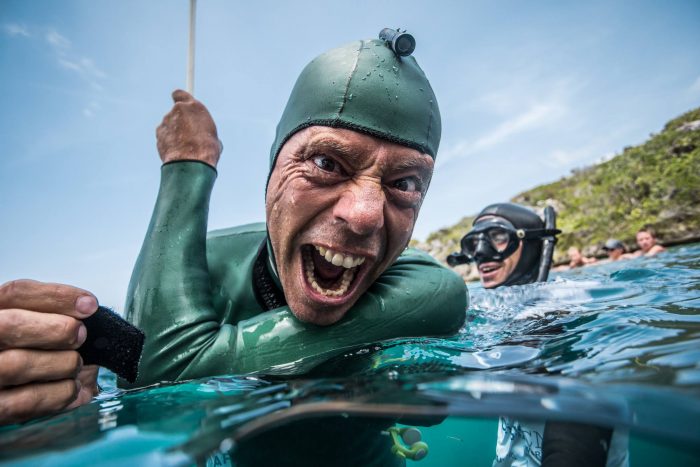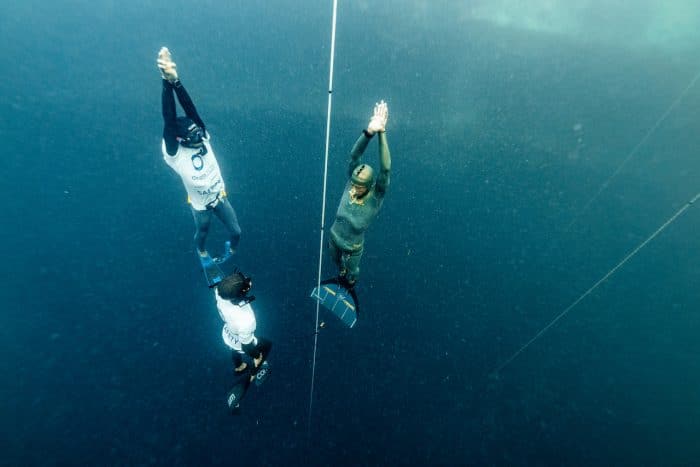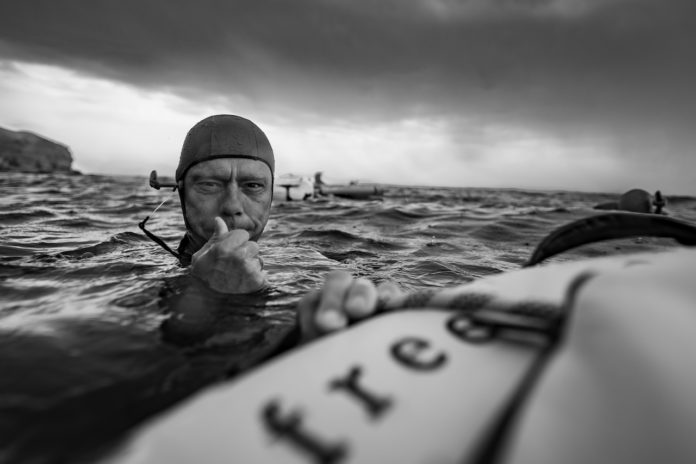It isn’t unusual that people will describe learning to freedive as life-changing, but few will have had as radical a turnaround as Danish competitive athlete Stig Pryds. Aside from being one of the warmest, friendliest and most positive freedivers you could meet, he also has an incredible story in which freediving played a huge part in pulling him out of the lowest point of his life This story of transformation has not only changed Stig’s life, and that of his partner Anja and daughters Alberte and Karen, but also means that today he is able to inspire and help others to improve their lives in the way he has helped himself.
Through freediving, Stig was able to heal himself from psoriatic arthritis (a chronic inflammatory joint disease, causing intense pain and extreme fatigue) that doctors could only treat with heavy medications. Stig went from needing to use a wheelchair on his worst days, to becoming an athlete at the top of his game, competing at the highest level, and who has broken all the Danish depth records.

Stig’s recovery began in 2013, after five years of illness. He describes himself as going from being “a self-employed business owner to a disability pensioner”. Supported by his partner Anja, he went through a detox to get himself off the strong pain medication he had been prescribed. Alongside this, he began following an alkaline diet, practicing yoga, and doing freediving classes in a pool, through which he discovered that he had a gift for breath-hold diving.
Within two weeks of depth training in Dahab with coach Johnny Sunnex that same year, Stig had reached an incredible 58m. Shortly after, he competed in the Danish Championships and dived to 70m in all three depth disciplines, and in September of the same year Stig was representing Denmark in the AIDA Depth World Championships in Kalamata where he achieved 80m in Free Immersion (FIM) and 66m in Constant Weight CWT). At the time of writing, Stig’s depth records are all National Records: 75m Constant No Fins (World Championships 2015); 102m FIM (Vertical Blue 2017); 105m CWT (Vertical Blue 2018).
Alongside being a competitive freediver, Stig is also a motivational speaker in Denmark, sharing his story with people who are also suffering from joint issues and pain, teaching them breathing techniques (he has developed an app for breathing practices – currently only in Danish), and informing them about diet and nutrition. He feels the ‘hell’ that he went through counts for something if it means he can help others to improve and recover from their pain. RedBull TV made a 45min documentary about his story for their “Breaking the day” series in 2016, and now Stig is writing his own book, to be published in Danish and English.
For those not fortunate enough to attend one of Stig’s talks, read on to get a deeper insight into how he trains, who he admires, and what freediving means for him.

DeeperBlue.com: What continues to inspire your freediving?
Stig Pryds: That’s a big question!…. [pause]… It’s this nice, calm thing that is happening when you’re freediving. The search for this inner silence, because it’s such an amazing feeling when you go down, and I just want to have more of this complete silence. It’s the search for this special feeling that you get when you dive. Every dive is a little bit different, but the sensation that you have down there.. it’s a place where I’m totally free. I’m completely free from everything and that is quite an amazing feeling. It’s like in a hurricane, or a twister.. in the middle of that there is complete silence, and everything around you is going pretty crazy and in the middle of it, there is just complete silence. That’s the reason I continue I think.
And also the thought that I’ll go a little bit deeper next time!
DB: Who do you most admire in the freediving world?
SP: Oh….. I’m really amazed about Alexey because he’s playing around, or it looks like he’s just playing, and that’s amazing.
And another one is Dave Mullins. He’s just mind-blowing. Such an amazing guy. He’s completely down to earth, nice to talk to, and he doesn’t make a big thing about it. It’s like he’s coming [to competitions] just for something fun to do, almost doing world records and then, doesn’t say anything about it, he gets Gold at the World Championship and never posts anything. It’s really cool that you can do something like that and not care about it afterward.

DB: What is/are your favorite place/s to freedive?
SP: Vertical Blue in the Bahamas. There’s two things about it: the safety team. No matter where I’ve been, you cannot compare the set-up with anywhere else because it’s so professional, and I feel really safe to dive there, and there’s no current, it’s the same every day. But the safety team is amazing there.
If you see what’s going on right now, in Kas and stuff [the CMAS World Championships in Turkey, 2018], I cannot believe what we saw there.
So, maybe when I go to Dominica [to compete in Blue Element Nov 2018 run by Johnny Sunnex and Sofia Gomez] it will be something else and I will have two special places to dive, but for now, it’s the Bahamas.
DB: Can you tell us about any exciting locations that you would you love to freedive?
SP: So that’s gonna be Dominica! I’m really looking forward to going there. When you go to Vertical Blue, you can do a few things there: you can get good fish tacos and you can go freediving! There are some lovely beaches, but when you have seen them, there’s not much else. Whereas I think in Dominica there are so many things to see and experience, so I think it’s going to be something really special.

DB: What would be your best piece of training advice for beginner/intermediate freedivers?
SP: Do some AIDA courses with someone who is an amazing trainer. Jonathan Sunnex is definitely the person to go to. He just knows what he’s doing. He pushes people to their limits. That would be my advice: contact Johnny!
Top freediving athletes favor a variety of cross-training methods. What is your preferred form of dry training and why?
I do hot yoga. Because I have this arthritis in my joints, if I’m pushing myself too much I get swelling in my joints, and he hurts really bad. So the only way I can do dry training is yoga, and I want to push it a little bit, so I do hot yoga, once or twice a week. It’s an amazing way to do training. You get more flexible with the heat, and you have an amazing feeling because you’re sweating madly, so you get really cleaned up inside, and you feel amazing afterward. I feel strong afterward. I drink 2 liters of water, 2 hours before, and then I have some salt afterward. I’ve tried other things, a little cycling in the summer, but if I do gym and squats then it hurts my knees and messes everything up. I think that’s why I have such amazing thin legs!!! When I was really sick from 2008-2013 I didn’t move my legs at all, so I lost a lot of muscles. That’s just how it is.
I’m also doing a lot of breathing exercises. I have a little routine I do every day.
DB: What is your pre-dive preference: breakfast or fasting?
SP: I have breakfast. I have my oats and my coffee. I’m 45 years old. I need coffee! I have it three a half hours before diving. I do overnight oats with chia seeds, hemp, and cocoa nibs, and a coffee, and I’m ready!
DB: What general nutritional principles do you follow?
SP: I eat really light food, a lot of vegetables, that’s the main thing I’m eating. I have a little chicken and fish, maybe 200-300 grams a week.., a lot of salad. In Denmark, we have a lot of kale, broccoli, so I eat a lot of that. And you digest that very fast, it will go through the system in 5-6 hours, so you have this light feeling afterward, but it gives enough energy and protein too. I have a little protein powder, and I’m just trying a special new fish oil, so we’ll see how it goes. It’s important not to use cheaper products because the body doesn’t absorb them. I’m going to try astaxanthin when I go to Dominica and see how that goes. Maybe I’ll go reeeeally deep this year!

DB: Freediving is a teacher: what important life-lessons has freediving given you?
SP: I see life completely differently now. In a better way. I think it’s because you are seeing yourself differently… I am seeing myself differently to before. Now it’s like I’m going through this amazing experience when I’m going diving. I’m really feeling so amazing when I’m doing it, and the love for the ocean and the sea is so big. It has changed my life completely. It has been an amazing journey. I have more respect for myself than I had when I started. For myself and my whole system, my body, my mind… I see myself as something better.. you know when you have a dog, you love the dog with all the love you can give him. I had done this for myself, and I had never ever done that for myself before. I never cared about myself before. Now I see myself completely differently. It has changed so much for me in a really positive way. Also, my life was really shitty before!!! That’s why it’s so big for me. It’s hard to explain. Before I needed to earn money, big car, nice stuff, TV, big house, everything had to be perfect, but there’s nothing in any of that.
DB: Where do you see yourself in 5-10 years?
SP: Oh man… in ten years I hope I’m doing some freediving in some way, not competitive but for fun, and I hope I’m doing a lot of teaching. Not freediving, but some of the techniques we are using, the way we are living, I’m teaching more of that. I’m doing it now, but I want to do it some more, because it helps a lot of people to do what we [freedivers] are doing, especially for different kinds of disease, it makes a really big difference to start breathing properly and eating more healthily. I don’t know why people don’t know how to eat, but they’re really bad. They can learn a lot. I want to do more of this.

DB: Can you describe your most memorable or significant dive?
SP: It must be one of the first dives. The first dive with Jonathan [Sunnex] in Dahab in 2013, I’d only tried freediving in the pool before then. Johnny told me how to equalize, how to relax, what to do on the line, about feeling heavy and starting to freefall. My first dive was completely mind-blowing! Equalising was fine, and I began to feel heavy and I could just go, and then the way down I was thinking “oh that’s amazing’ and suddenly I have my lanyard on my leg, and the line wasn’t longer, and I pulled myself back up again and I said “Johnny I want some more of this!!”
DB: Which of your achievements are you most proud of, and why?
SP: My last dive at Vertical Blue this year [2018], because I have chased this record for three years. I have been down there a few times but I haven’t been able to get up because of my legs. Last year I changed to the Molchanovs fin, and I was doing as much training in the pool as I could, so my technique was getting so much better, and this year I made it. And it was amazing! So not I have all three national records. But because I’ve chased it for such a long time, it was pretty cool. And I did the record three times! 102, 103 and then 105m!
The fin is the softest one, and then I don’t have to use my knees, I get the movement from my hips. Then, when I would get too tired, I would start to bend my legs with a stiffer fin. With a softer fin, I’m much faster, but I think it’s also about the pool training. I’m doing sprints, as fast as possible, and you have to move from the hips, which is much easier. When you’re turning at the bottom plate you’re trying not to go completely fast, but you just need to keep going and continue continue continue no matter if things start hurting. That’s what made the difference this year I think. I didn’t feel my legs. The first dives, 102 and 103 felt fine. On the 105 I was maybe starting to feel tired and I felt my legs a little bit more, but maybe because it was the end of the comp so you are generally more tired by then.
It was my last dive and I always try to enjoy my last dive as much as possible, so I went a bit fast on the way up, just for fun, so maybe that’s why my legs felt a little tired. And also with Diveye, you can see everything, which is so cool. When I’m missing freediving, I can go back and see the dives again. I show the dives when I do my talks and people are mind-blown by seeing it!

